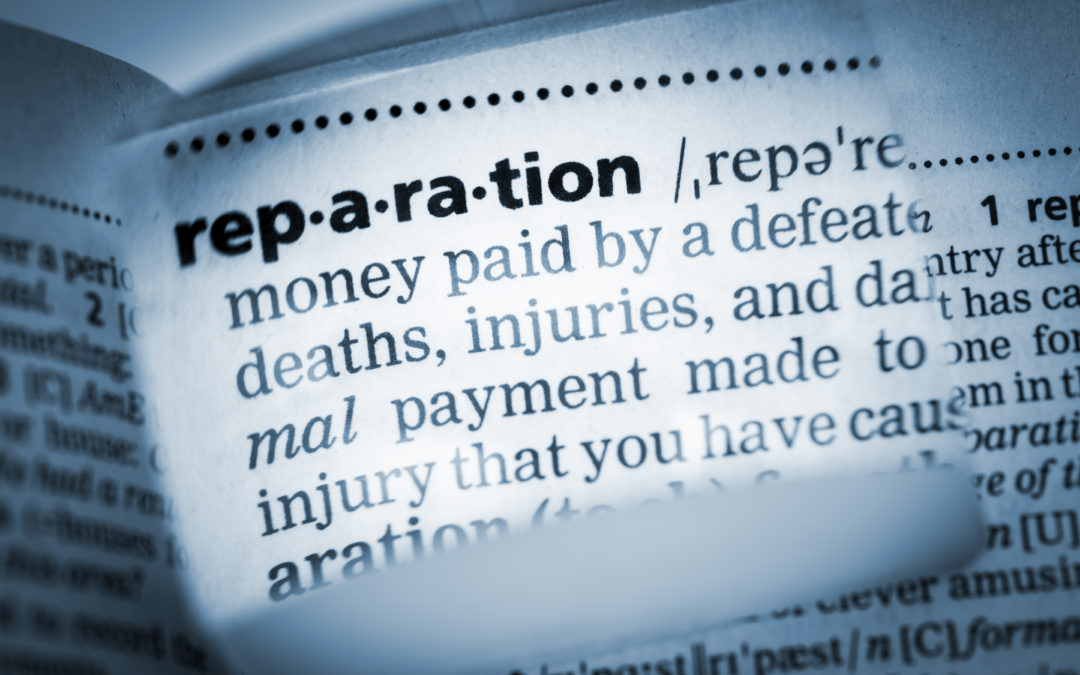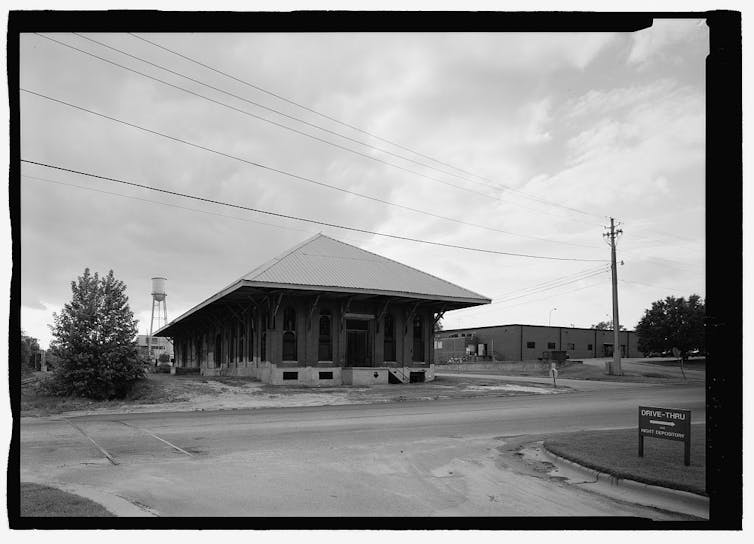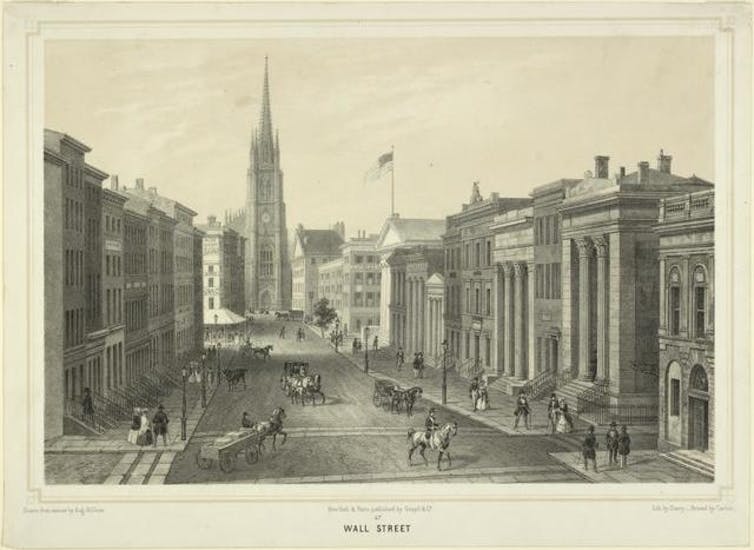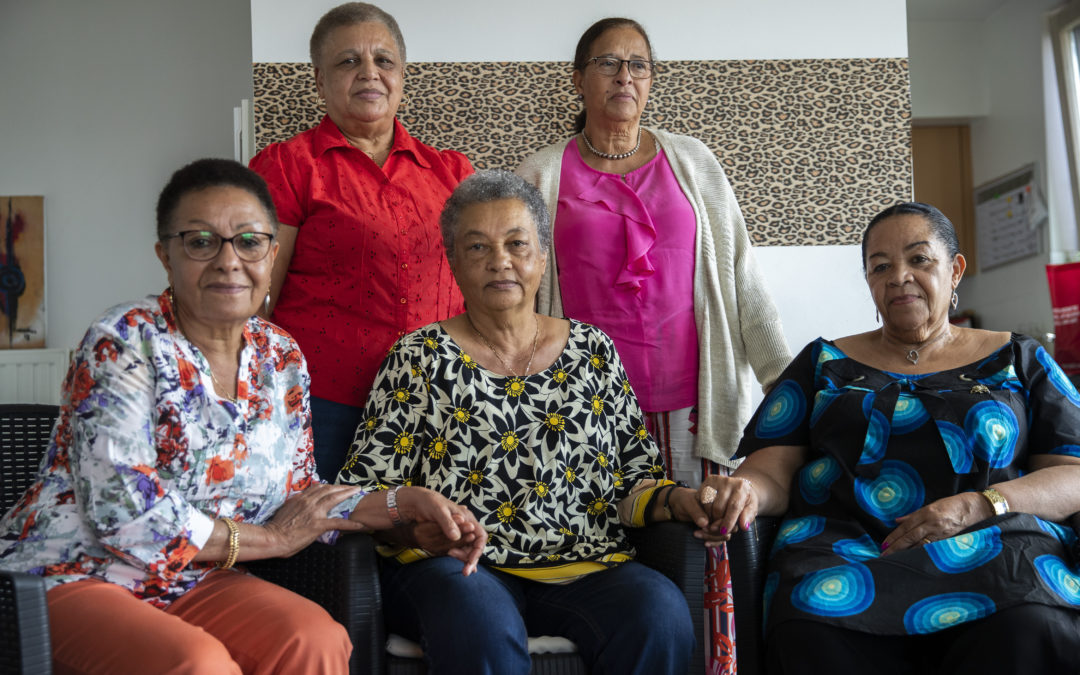
by Samuel Petrequin, Associated Press | Oct 20, 2021 | Headline News |
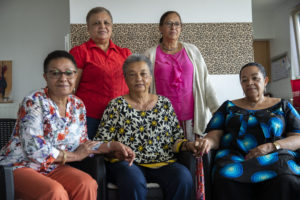
FILE – In this Monday, June 29, 2020 file photo, clockwise from top left, Simone Ngalula, Monique Bitu Bingi, Lea Tavares Mujinga, Noelle Verbeeken and Marie-Jose Loshi pose for a group photo during an interview with The Associated Press in Brussels. Five biracial women born in Congo when the country was under Belgian rule who were taken away from their Black mothers and separated from their African roots are suing the Belgian state for crimes against humanity. The case is being examined on hursday, Oct. 14, 2021 by a Brussels court. (AP Photo/Francisco Seco, File)
‘BRUSSELS (AP) — A court in Brussels has started considering a crimes against humanity lawsuit brought by five biracial women who were born in Congo and taken away from their Black mothers when they were little and the country was under Belgian colonial rule.
Lea Tavares Mujinga, Monique Bintu Bingi, Noelle Verbeken, Simone Ngalula and Marie-Jose Loshi are suing the Belgian state in hopes it will recognize its responsibility for the suffering of thousands of mixed-race children. Known as “metis,” the children were snatched away from families and placed in religious institutions and homes by Belgian authorities that ruled Congo from 1908 to 1960.
“My clients were abducted, abused, ignored, expelled from the world,” lawyer Michele Hirsch said Thursday as a court in the Belgian capital examined the civil case. “They are living proof of an unconfessed state crime, and soon there will be no one left to testify.”
The five women have requested compensation of 50,000 euros ($55,000) each.. The court is expected to deliver a verdict within six weeks.
The five women, all born between 1945 and 1950, filed their lawsuit last year amid growing demands for Belgium to reassess its colonial past.
In the wake of protests against racial inequality in the United States, several statues of former King Leopold II, who is blamed for the deaths of millions of Africans during Belgium’s colonial rule, have been vandalized in Belgium, and some have been removed.
In 2019, the Belgian government apologized for the state’s role in taking thousands of babies from their African mothers. And for the first time in the country’s history, a reigning king expressed regret last year for the violence carried out by the former colonial power.
Hirsch said Belgium’s actions are inadequate to what her clients experienced.
“The Belgian state did not have the courage to go all the way, to name the crime, because its responsibility incurred damages,” the lawyer said.. “Apologies for history, yes, but reparations to the victims, no.”
Lawyers say the five plaintiffs were all between the ages of 2 and 4 when they were taken away at the request of the Belgian colonial administration, in cooperation with local Catholic Church authorities.
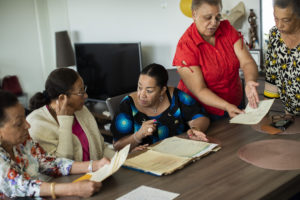
FILE – In this Monday, June 29, 2020 file photo, from left, Marie-Jose Loshi, Monique Bitu Bingi, Lea Tavares Mujinga, Simone Ngalula and Noelle Verbeeken speak with each other as they as they look over papers during an interview with The Associated Press in Brussels. Five biracial women born in Congo when the country was under Belgian rule who were taken away from their Black mothers and separated from their African roots are suing the Belgian state for crimes against humanity. The case is being examined on hursday, Oct. 14, 2021 by a Brussels court. (AP Photo/Francisco Seco, File)
According to legal documents, in all five cases the fathers did not exercise parental authority, and the Belgian administration threatened the girls’ Congolese families with reprisals if they refused to let them go.
The children were placed at a religious mission in Katende, in the province of Kasai, with the Sisters of Saint Vincent de Paul. There, they lived with some 20 other mixed-race girls and Indigenous orphans in very hard conditions.
According to the lawyers, the Belgian state’s strategy was aimed at preventing interracial unions and isolating métis children, known as the “children of shame,” to make sure they would not claim a link with Belgium later in their lives.
Legal documents claim the children were abandoned by both the state and the church after Congo gained independence, and that some of them were sexually molested by militia fighters.
“If they are fighting for this crime to be recognized, it is for their children, their grandchildren. Because the trauma is transmitted from generation to generation,” Hirsch said Thursday. “We ask you to name the crime and to condemn the Belgian state.”
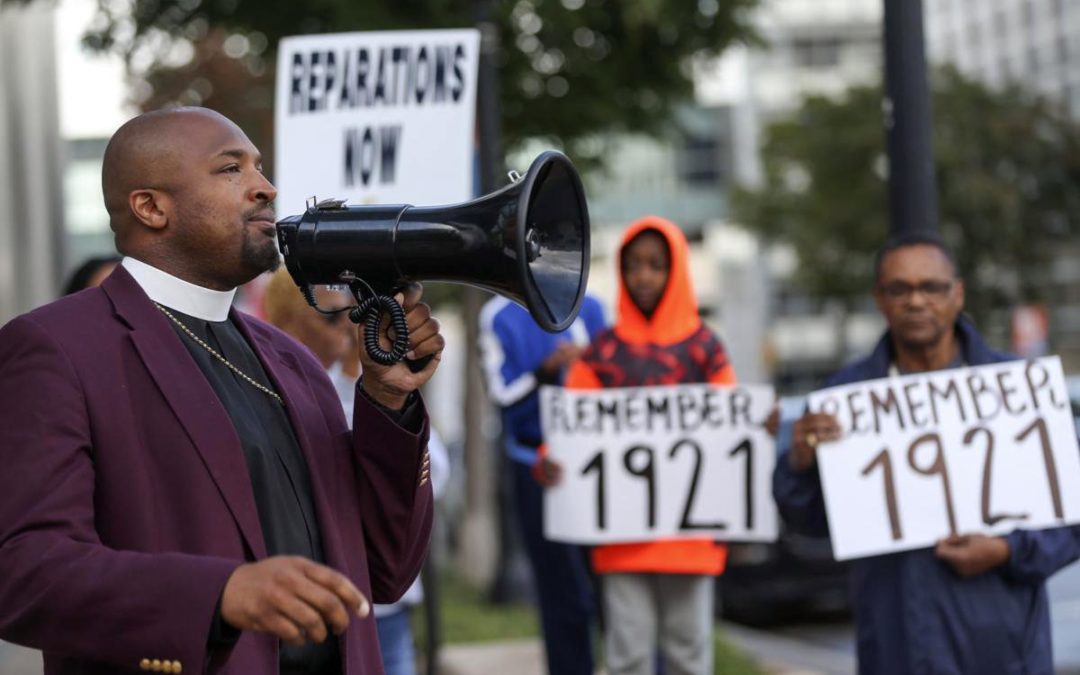
by Adelle M. Banks, RNS | Jun 2, 2021 | Black History, Headline News |
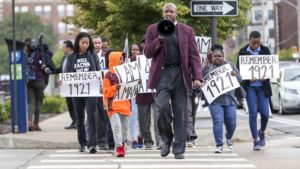
(RNS) — On the first Wednesday in May, as the centennial of the Tulsa massacre approached, the Rev. Robert R.A. Turner stood outside Tulsa City Hall with his megaphone, as he does every week.
“Tulsa, you will reap what you sow and that which you have done unto the least of these my children, Jesus said, you have done also unto me,” said Turner, 38, the pastor of Historic Vernon African Methodist Episcopal Church, captured on a video posted on Facebook.
“We come here to say, for your own benefit, you ought to do reparations not tomorrow, not even next week, not next month, not next year, but we demand reparations now!”
Turner’s Vernon AME is one of the plaintiffs in a suit filed in September that calls for the city of Tulsa and other defendants to pay reparations to relatives of victims and survivors of the May 31, 1921, massacre that destroyed a part of town known as “Black Wall Street.”
Beginning with false rumors spread though the Oklahoma city that a young Black man had assaulted a white female elevator operator, within about 16 hours, a white mob killed an estimated 300 Black people and destroyed thousands of homes, businesses and churches.
As Tulsa pauses to mark the somber centenary in its Greenwood district, where Black Wall Street was located, Turner and other Black people of faith are among those saying the time has come to repay as well as to remember.
The lawsuit argues that the tragedy is a continuing “public nuisance” that Tulsa should remedy through monetary means.
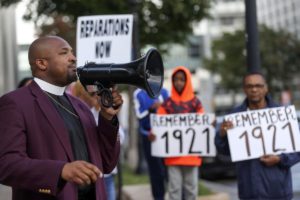
Among the suit’s petitions to the Tulsa County District Court are payments to descendants of those who were killed, injured or displaced by the massacre; development of educational and mental health programs for individuals and organizations in Greenwood and North Tulsa; and a scholarship program for “Massacre descendants” for post-secondary education in Oklahoma.
The suit states that Vernon AME Church, “founded in 1905, is the only standing Black-owned structure from the Historic Black Wall Street era and the only edifice that remains from the Massacre. Vernon’s sanctuary burned in the Massacre. The basement was the only part of the red brick building that remained.”
The church joins other plaintiffs in charging that they never received resources to recover from the trauma and damage of the massacre.
The city, responding in court documents to the suit, questioned the framing of its claims and the idea that the city’s current problems can be attributed to 100-year-old wrongs.
“At its base level, Plaintiffs are attempting to seek reparations for the events of June 1921 while working around the inherent statute of limitations problems that have thwarted other lawsuits bringing similar claims,” the city argued.
It added that the suit’s claims of continuing racial inequalities are “nebulous” and said “community wide issues such as racial disparity are caused by a number of factors and cannot be traced to specific actions or omissions to act of or by the City, nor is it a nuisance that can be simply abated by the City.”
In 2001, the Oklahoma Commission to Study the Tulsa Race Riot of 1921 called for reparations for the massacre, including payment to survivors and descendants, a scholarship fund, establishment of an economic development zone in the historic area, and a memorial for reburial of remains of victims found in unmarked graves.
“Perhaps this report, and subsequent humanitarian recovery events by the governments and the good people of the state will extract us from the guilt and confirm the commandment of a good and just God — leaving the deadly deeds of 1921 buried in the call for redemption, historical correctness, and repair,” wrote then-state Rep. Don Ross in the prologue of the report.
Turner, who arrived in the city in 2017 to lead his church, agrees with all of the commission’s recommendations and hopes for a full criminal investigation. His petition for reparations has been signed by more than 26,000 people.
“This is about sin and an abominable sin — racism,” said the minister, who calls the massacre a “genocide of people simply because of the color of their skin.”
Gregory Thompson, co-author of a new book, “Reparations: A Christian Call for Repentance and Repair,” said the Tulsans’ demands show how the movement for reparations has extended beyond atonement for the United States’ involvement in slavery to repairing societal ills, and that not just the federal government but local and regional officials are being called to account.
“It’s not to say that I don’t think the federal government should be involved — I do,” said Thompson, a white scholar who directs Voices Underground, a team of researchers and community members focused on the history of the Underground Railroad in the Philadelphia area. “But I think community-based reparations allow African American leaders a lot more agency in this conversation than if it’s located at the federal government, which is not equitably representative of African Americans.”
Regional reparations initiatives have become more common of late. Since the 1990s, descendants of survivors of the 1923 massacre in the majority-Black enclave of Rosewood, Florida, have received state scholarships.
In March, the Evanston City Council, in Illinois, began approving reparations that provide mortgage and other housing assistance to local Black residents to make amends for racially discriminatory housing practices. In April, Virginia Gov. Ralph Northam signed a bill mandating that five of the state’s older public universities pay for scholarships or community redevelopment programs, starting in 2022, to benefit descendants of enslaved workers who built them.
Vernon AME is one of 23 churches in Greenwood that predate the massacre, of which 13 survived, according to a tally by Faith Still Standing, an ecumenical group of congregations that have rebuilt in the area or beyond it.
The Rev. Robert Givens pastors Christ Temple Christian Methodist Episcopal Church, a congregation that was founded in Greenwood but has since moved. Its original building was still new when it was destroyed in the massacre.
“When we think of Black Wall Street, it was tremendously a thriving area of all-Black businesses,” said Givens. “So a lot of the churches were just now getting started in that area” when they were burned down.
“Nothing was ever done for them or to help them in that situation,” said Christ Temple’s trustee board chairperson, Annette Gathron, of the people who lost homes, businesses and belongings along with their churches.
Some of those whose families survived the massacre have become key figures in the city’s Black history. The late John Hope Franklin, the famed historian, was a member of Christ Temple, and his father, attorney B.C. Franklin, helped pay off the church’s mortgage on the brick building it constructed after the massacre.
Gathron said she hopes to attend some of the worship services marking the centennial.
A ” Unity Day Worship Guide ” for congregations to use on the last Sunday in May is included in an online list of options for commemorative activities.
Gathron said she also intends to keep younger members of her family aware of the history of the city where she has lived for more than 60 years.
“I think that it’s good that we are remembering and I plan to take my great-grands to some of this so they can understand the struggles that we have had,” she said.
She traditionally takes nieces and nephews visiting from across the country on a walking tour through historic Greenwood, including a stop at Vernon AME.
“I think it’s important for them to know that they can achieve because this, at one time, was a very thriving community.”
On May 31, Tucker’s 130-member church, which opened in a rebuilt sanctuary in 1928, plans to dedicate “a prayer wall for racial healing” that will include an exterior wall of the basement that survived 100 years ago.
Once built, Turner hopes it will draw people of all faiths and none for prayer and meditation. “The idea behind it is to have people of all nations come and to pray and talk to God to help us with this racial healing that we need in the world,” he said.
You can hear from Pastor Robert Turner alongside other leaders virtually tonight (June 2, 2021) at Friendship West Baptist Church in Dallas, TX as they commemorate the Tulsa Race Massacre of 1921 in A Sankofa Moment. Conversation will also feature Nancy St. Jacobs, VP of Community Business Development for Truist Bank, and Lamar Tyler, Founder of Traffic Sales & Profit moderated by Dr. Frederick D. Haynes III.
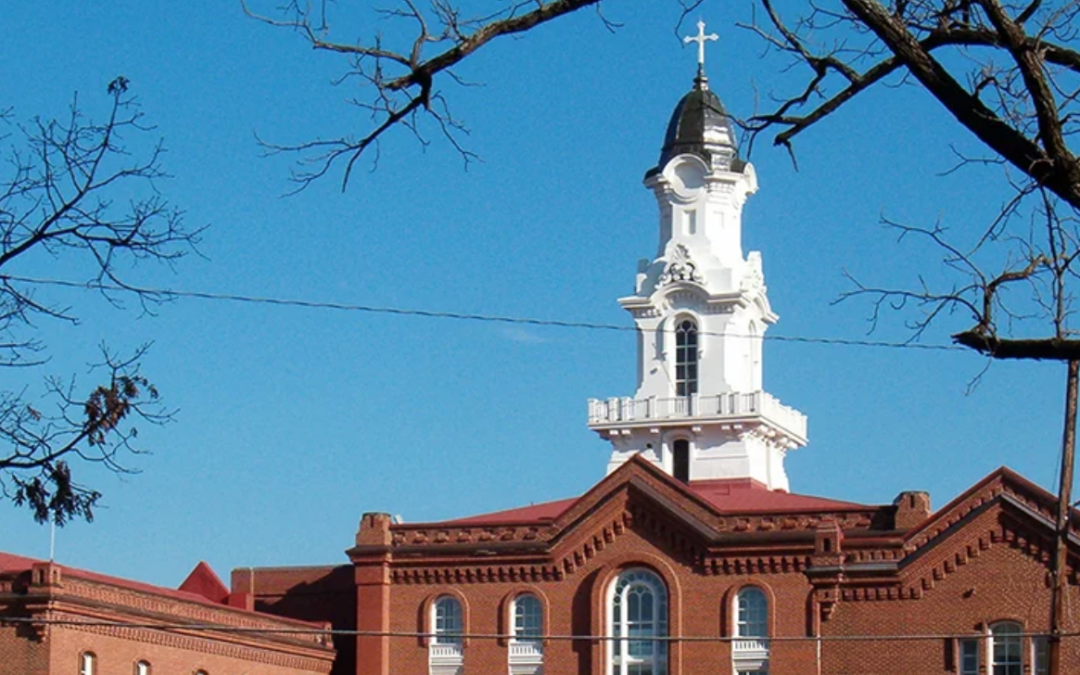
by Adelle M. Banks, RNS | Sep 21, 2019 | Social Justice |
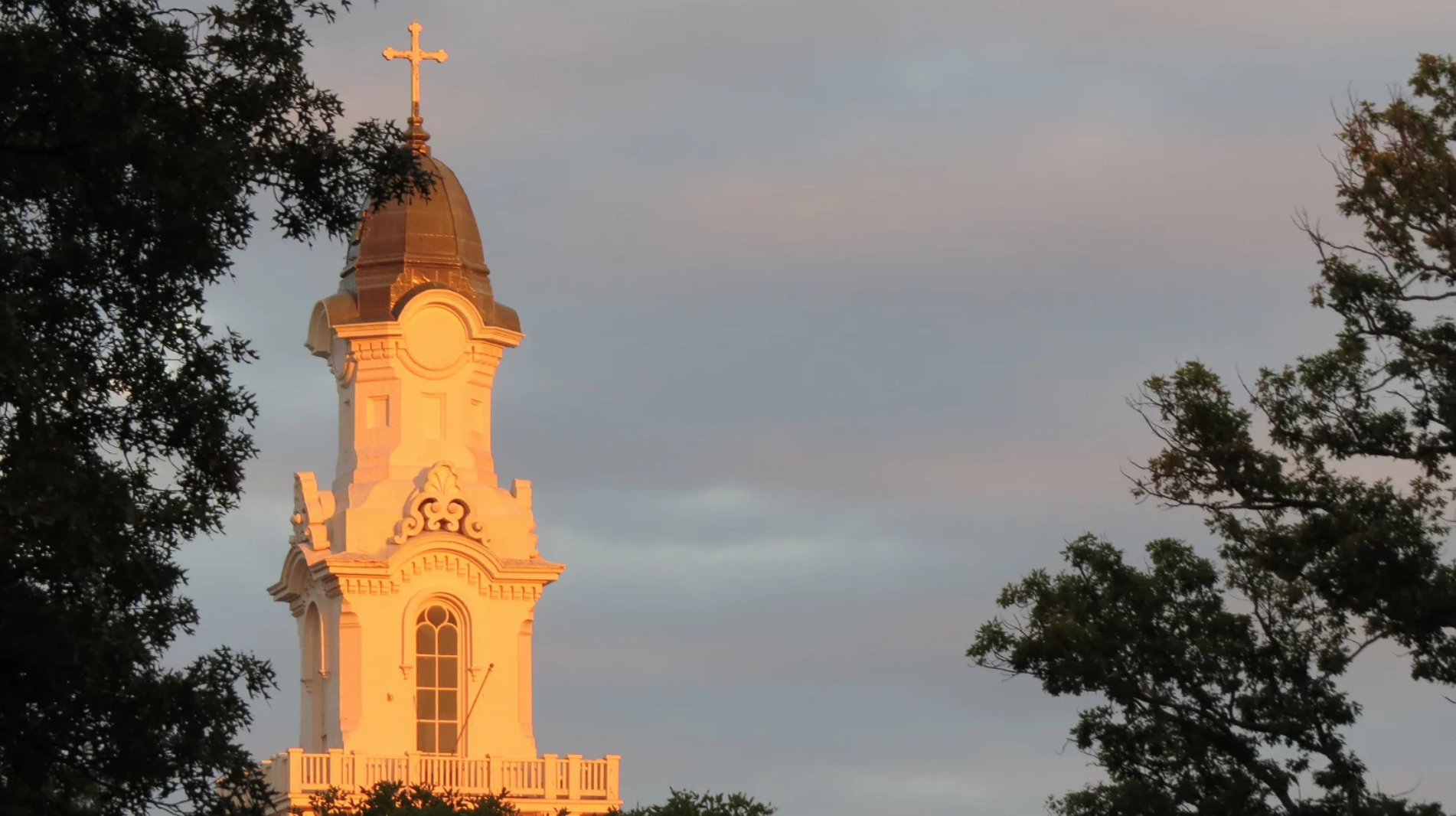
An Episcopal seminary in Virginia has announced plans to create a $1.7 million endowment fund whose proceeds will support reparations for the school’s ties to slavery.
Virginia Theological Seminary said that enslaved persons worked on its campus and the school “participated in segregation” after the end of slavery.
“This is a start,” said the Very Rev. Ian S. Markham, president of the Alexandria-based seminary, in the statement. “As we seek to mark (the) Seminary’s milestone of 200 years, we do so conscious that our past is a mixture of sin as well as grace. This is the Seminary recognizing that along with repentance for past sins, there is also a need for action.”
A spokesman for the seminary said officials know of three buildings on its campus that were built with slave labor, including Aspinwall Hall, where the dean’s and admissions offices are located.
“We do want to honor those who worked in this place and we want to provide financial resources for their descendants,” said Curtis Prather, the seminary’s director of communications. “The Office of Multicultural Ministries will take the lead in the exhaustive research that will need to take place.”
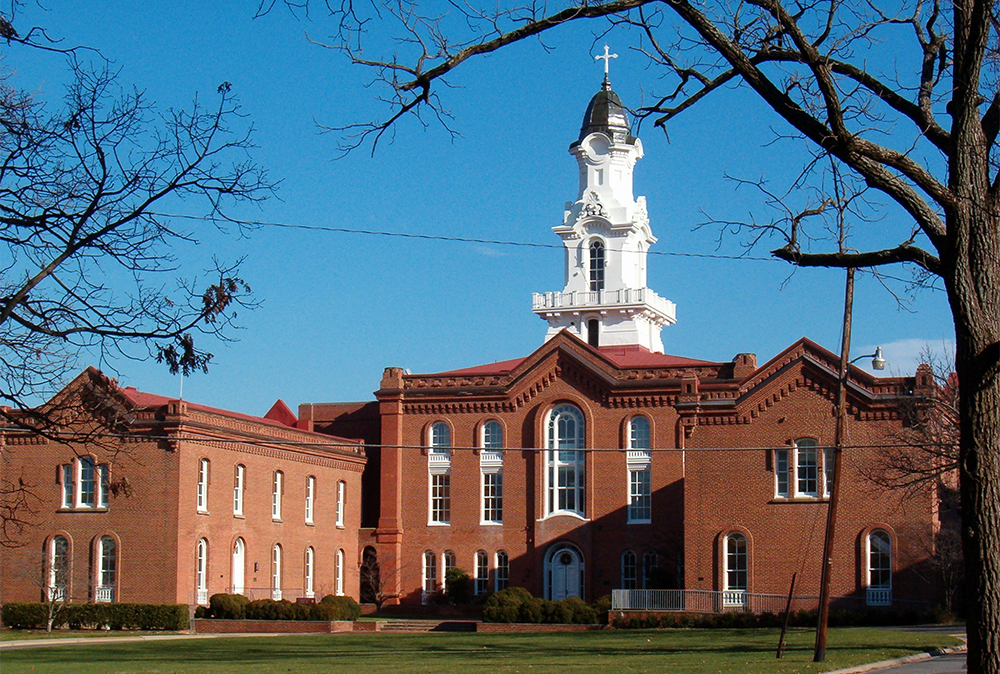
Aspinwall Hall at Virginia Theological Seminary was one of three buildings on campus built with slave labor. Photo by John W. Cross/Creative Commons
The seminary, which was founded in 1823 but admitted its first African American student in 1951, raised the funds for the endowment with a capital campaign. School officials estimate that they will spend $70,000 annually from accumulated interest on reparations.
The decision comes as other institutions of higher learning, some with ties to religion, have mulled whether to offer forms of reparations or not.
In 2017, Georgetown University apologized for its involvement in the 1838 sale of more than 270 enslaved persons that kept the Catholic-run school from bankruptcy. The school renamed two buildings that once honored former university presidents who were priests and supporters of the slave trade. A year earlier, Georgetown announced that it would give preferential status in the admissions process to descendants of the enslaved people who had been owned by Maryland Jesuits.
Jennifer Oast, author of “Institutional Slavery: Slaveholding Churches, Schools, Colleges, and Businesses in Virginia, 1680-1860,” said the seminary’s “momentous announcement” is more noteworthy than the nonbinding vote by Georgetown students in the spring to add a student fee whose proceeds would benefit the descendants of the slaves sold more than a century and a half ago.
Georgetown spokesperson Meghan Dubyak said the school’s board of directors will not have an “up or down” vote on the student referendum but “will engage thoughtfully and with the most careful consideration of the issues” raised by it.
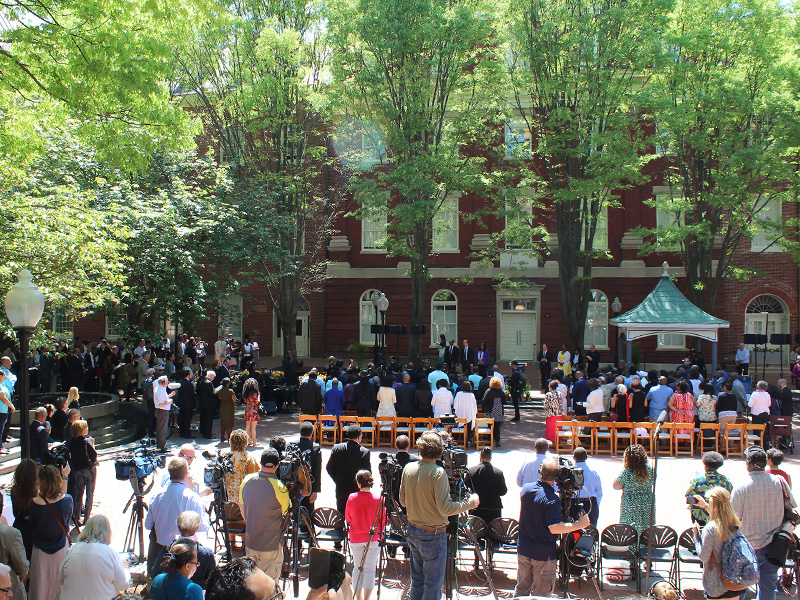
Crowds of slave descendants and Georgetown University students and staffers gather for a dedication ceremony of two buildings at the school that were renamed, one in honor of a slave sold by Maryland Jesuits, and another for a free black woman educator, on April 18, 2017. RNS photo by Adelle M. Banks
“To my knowledge, this is the most substantial direct financial reparations effort by a university,” said Oast, chair of the history department at Bloomsburg University in Pennsylvania. “What makes this action by VTS more significant is that it has been undertaken by the university itself, and is fully funded.”
Quardricos Driskell, who teaches religion and politics at George Washington University’s Graduate School of Political Management, agreed.
“VTS would by definition be the first to have a fund — a University-established led form of reparations,” Driskell, pastor of Beulah Baptist Church, located about three miles from the seminary, told Religion News Service in an email message.
Other institutions have chosen to recognize their connections to slavery without making monetary reparations. Last year, Southern Baptist Theological Seminary, a flagship institution of the Southern Baptist Convention in Louisville, Kentucky, released a report about its founders condoning slavery and owning slaves, but six months later denied a request from an interracial ministers coalition for financial support for a nearby black college.
Virginia Theological Seminary currently has an enrollment of about 200 master’s and doctoral level students.
The school intends to determine with stakeholders how the income from the endowment fund will be distributed. It said some of it will be allocated to descendants of enslaved persons who worked at the seminary and to assist the work of African American alumni, especially those involved with historic black churches. It also plans to encourage African American clergy in the Episcopal Church and support programs that promote inclusion and justice.
“Though no amount of money could ever truly compensate for slavery, the commitment of these financial resources means that the institution’s attitude of repentance is being supported by actions of repentance that can have a significant impact both on the recipients of the funds, as well as on those at VTS,” said the Rev. Joseph Thompson, director of the seminary’s Office of Multicultural Ministries, in a statement.
“It opens up a moment for us to reflect long and hard on what it will take for our society and institutions to redress slavery and its consequences with integrity and credibility.”




